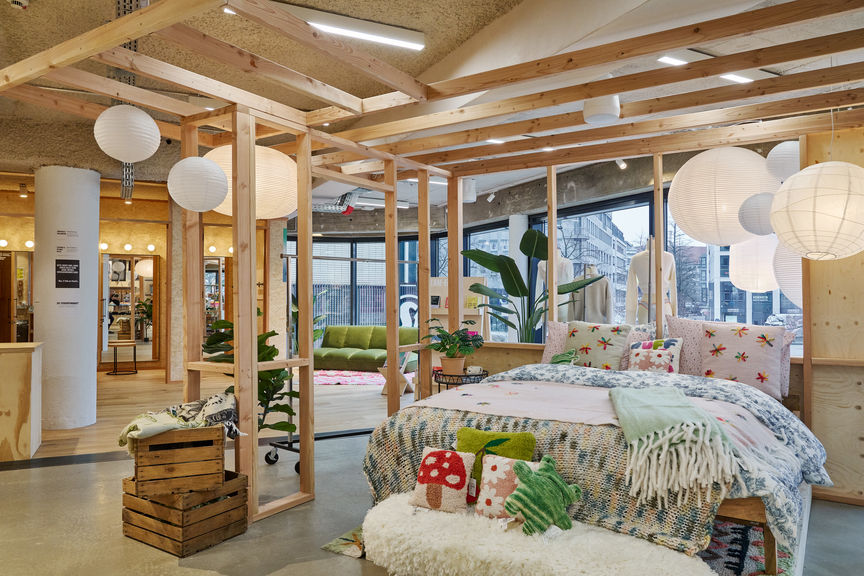Retail trade
The Hannover Region is one of the highest-turnover retail locations in Germany. For 2024, sales expectations for the region are around EUR 8.57 billion in the retail sector, an increase of more than EUR 400 million compared to the previous year.
Hannover's prime locations Georgstraße, Große Packhofstraße, Bahnhofstraße and Karmarschstraße are once again reliably attracting customers to the city center after several difficult years. Retail agglomerations, shopping centers, city district locations and attractive city centers characterize Hanover as a retail location in the surrounding area.
Market sentiment and trends
The frequency data for Hanover, which is stable overall at a high level, shows for 2023 and the first half of 2024 that the current weak propensity to spend among consumers is only causing slight fluctuations in visitor numbers in Hanover's city center, both in comparison with 2022 and with the pre-corona year 2019.
According to market participants, the positive trend can also be seen in lettings in Hannover's city center locations. After exceeding the pre-coronavirus level again in 2022 and 2023, the first half of 2024 saw a significant increase in take-up of 42 % to a total of around 5,500 sqm compared to the same period in 2023.
This means that more space was already rented in mid-2024 than in 2023 as a whole (just under 5,000 sqm).
However, increasing footfall can only counteract the still very tense and difficult situation in the bricks-and-mortar retail sector to a limited extent. Despite high footfall and positive movement in the retail sector, many retailers are struggling not only to attract customers to their stores, but also to sustainably increase their sales.
Prime rents under pressure
Although the decline in rents estimated to be achievable in prime locations remains rather moderate, a steady downward trend in prime rents for retail space can be observed. At the end of 2023, prime rents settled at around EUR 160 per sqm; market participants expect them to stabilize in the current year.
However, an increasing shrinkage of the location areas in which these prime rents can be realized can still be observed. Significant rent reductions are to be expected outside the absolute top locations.
This is also leading to a shift in the retail mix, with certain locations becoming more affordable again for retailers and restaurateurs. Overall, there are significantly more vacancies in the city center in all locations than before the pandemic.
By contrast, specialist retail locations with a focus on food retail are very stable and have only low vacancy rates. City district locations and integrated retail locations in the surrounding area have benefited from their proximity to customers and their local supply function, not least during the coronavirus pandemic.
Nevertheless, retail companies are also adopting a cautious stance in these locations, which is having an impact on the demand for and positioning of retail properties on the investment market.
Investment market environment
While the increase in net initial yields for prime locations is attributable to a mix of the interest rate environment and risk revaluation, in the case of retail warehouse locations it is almost exclusively due to the change in the interest rate environment.
According to the current forecast, the achievable prime yield for a commercial building in a prime location will rise to around 4.8 % over the course of the year and to 5.6 % for retail warehouse locations (plus 30 basis points in each case).
Outlook: Structural changes in the city center
The pressure on the retail sector has been increasing, and not just recently, due to many insolvencies and rising vacancy rates. It has long been clear to industry experts and local market players that the city centers in the city and region of Hanover are facing drastic structural and strategic changes.
This applies in particular to the city center of Hanover, which has been affected by the closure of two Galeria Group department stores. The coronavirus pandemic, inflation and the reluctance to spend - also due to other crises - should not be seen as the cause of the retail sector's difficulties; they are merely exacerbating negative trends in bricks-and-mortar retail that have existed for some time.
In recent decades, city centers have been shaped primarily by the retail sector. The core task of future-oriented development of city center locations will be to see change as an opportunity that creates space for new concepts and ideas.
Multifunctional city center concepts will be needed in the future: Housing, culture, gastronomy, quality of stay, accessibility by public transport or bicycle and services alongside retail will become more important as development components.
This will be a slow and difficult development process that will require patience and capital from everyone involved and which has not yet been accepted by all inner-city stakeholders.
Hanover city center: New concepts successfully tested
The challenges for bricks-and-mortar retail and, with it, for city centers therefore remain diverse. There are good reasons to believe that the retail and service sector will master the current phase through adaptability, courage and new concepts.
The high footfall in Hanover's city center shows that city center locations remain attractive despite the crisis in the retail sector. There is potential here that can be exploited by implementing new concepts and ideas.
Successful model aufhof as an inner-city experimental space
The recently completed interim use project aufhof in the former Kaufhof department store by the Marktkirche is emblematic of the transformation of the city center. Between June 2023 and July 2024, around 5,000 square meters of the first floor of the building were used as a forum for urban development and building culture, for innovative "hands-on" science and for a creative approach to the city's future challenges.
More than 250,000 visitors came to around 750 events and 30 exhibitions. The project is therefore also an example of the transformation of the city centre, which has to adapt to the consequences of climate change, economic and social changes and the digitalization of all areas of life.

